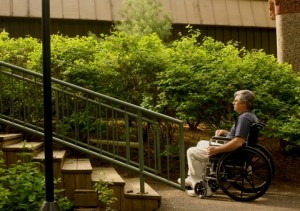Affordable, Accessible Housing Increasingly Out Of Reach For People With Disabilities
 People living with disabilities face a significant problem – the lack of affordable, accessible housing.
People living with disabilities face a significant problem – the lack of affordable, accessible housing.
Approximately 54 million Americans have at least one disability, constituting the largest minority group in the nation. People with disabilities often spend a disproportionate share of their income to secure housing that is both safe and suitably accessible.
Federal guidelines define housing as “affordable” if total costs, including rent, utilities, insurance and taxes, don’t exceed 30 percent of a renter’s household income. Individuals currently eligible for Supplemental Security Income (SSI) in California receive $854.40 per month, while couples receive $1,444.20.
Under the 30 percent housing affordability guidelines, an individual living solely on SSI should pay no more than $256.32 per month for housing and a couple no more than $433.26.
With this in mind, affordable housing is nearly impossible for people with disabilities to find and thousands and thousands of names are on waiting lists throughout the state.
“The reality is that most all of us will experience a disability within our lifetime, which may prompt the need for affordable, accessible housing,” said Bob Hand, Executive Director of Resources for Independence, Central Valley. “However, for people with permanent disabilities, the need is “now” and affordable housing resources simply aren’t available.”
Affordability is just one problem. Accessibility also is a challenge. Several California communities are trying to address the lack of accessibility by, among other things, adopting the state’s Universal Design Model Ordinance. The intent of the ordinance is to increase opportunities for persons with temporary, developing or permanent disabilities to “age in place.”
“Trying to decipher the maze of information and resources can be overwhelming,” said Hand, “and that’s where independent living centers (ILCs) come into play. ILCs provide a number of services to people living with disabilities, including educating them about housing options as well as assisting them in negotiating rents and working with landlords. But more needs to be done.”
According to experts in the industry, education is the key to making a difference. Individuals need to be made aware of programs and agencies that are working with lenders, housing authorities and service providers in creating innovative housing options, such as “smart-home” technology, within their locale. Experts also believe it’s imperative for people with disabilities to talk to elected leaders about their real-life experiences and the need for policies that improve affordability and accessibility.
According to Elsa Quezada, Chair of the California State Independent Living Council, “By providing people with timely and pertinent information, training and education, we can arm them with the tools they need to live independently and not take “no” for an answer.”
With AAOA, landlords have resources at their fingertips. Check out our Landlord Forms page.
American Apartment Owners Association offers discounts on products and services for landlords related to your rental housing investment, including rental forms, tenant debt collection, tenant background checks, insurance and financing. Find out more at www.joinaaoa.org.















 Accessibility
Accessibility